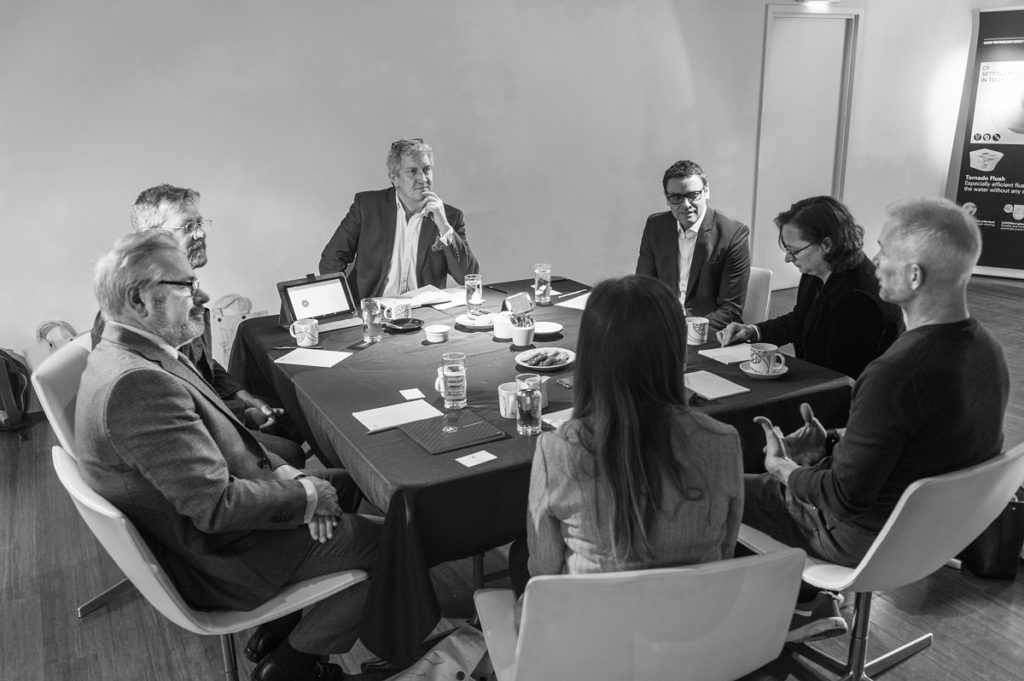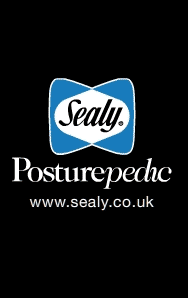The Hotel Bathroom – Looking Forward
A roundtable event, hosted by TOTO
Earlier this month a group of industry luminaries gathered to discuss what can be done to improve the hotel bathroom. Representing architects, designers, operators and manufacturers the group shed light on a variety of topics including accessibility, sustainability, technology and guests’ expectations.
The Experts

Rachel Johnson is Senior Vice President and Studio Director of Wimberly Interiors, London, and is responsible for all London projects as well as many overseas. Together with WATG, Wimberly Interiors are the world’s leading design consultants in the hospitality industry.

Rob Steul, Creative Director, Edwardian Hotels. A qualified architect, Rob joined Edwardian Hotels London in 2013 as Creative Director following 25 years of designing hotels and resorts globally as VP of Hospitality Design for HOK Architects and later as Principal Partner for Woods Bagot. Rob is leading the design of Edwardian Hotels’ new build lifestyle hotel in Leicester Square, called The Londoner.

Una Barac is the Founder and Executive Director of Artelior, the architecture and interior design studio. Continuously busy, Artelior work on projects around the world for clients such as Park Plaza, Four Seasons Hotels, Art’otel, Courtyard by Marriott, Swissotel and Sofitel M Gallery.

Peter Hancock is an author, hotelier and respected industry spokesperson. Peter is now Chief Executive of Pride of Britain Hotels, a collection of never more than 50 independent, mostly family-owned hotels in some of the most beautiful locations around the British Isles. Member hotels include The Capital, The Goring, Glenap Castle, The Vineyard, Gravetye Manor, Lucknam Park and Calcot Manor.

Martin Hulbert is the founder of Martin Hulbert Design and has completed a wide variety of residential & hotel projects around the world. He is the award-winning designer of The Grove Hotel, Coworth Park for the Dorchester Collection, the Dorchester Spa, the Treehouse Suites at Chewton Glen, Barnsley House and Cliveden Terrace Dining Room & Spring Cottage.

Floyd Case is TOTO’s Specification & Projects Manager, based at their UK Office and Showroom in Clerkenwell, London.

Stirling Johnstone, (Mediator) Publisher & Editor of GS Magazine online.
Question: What makes the Perfect Bathroom?
Peter: Firstly, it needs to be sympathetic with the building it’s in, it must fit in with the architecture. Secondly, from a luxury point of view, space is what we often define as a part of luxury, and ease and convenience. Thirdly, you shouldn’t need to have to figure out how the bathroom works! And fourthly, I believe it should be a space that exceeds what most of us have at home in terms of luxury, comfort and design.
Una: It certainly needs to be very special for the guest but as designers we must be aware of wear and tear. We need to ensure that the room can cope with years of use without it becoming shabby or worn, or dating. This means choosing materials that are robust and won’t fade, so that they don’t have the opportunity to age. And now we have no excuses because there are so many great materials on the market that we can choose to create unique spaces.
Rob: I’m happy to focus on longevity and materiality. As I’m now more involved with the operational side of hotels, and not just the design, I understand more about the maintenance and the importance of keeping the space clean and looking new. As far as the perfect bathroom is concerned, for me it’s where there’s no definition between where the bedroom space ends and the bathroom begins. It should be one complete guest experience. Not necessarily open-plan. That doesn’t suit everyone, but a space of continuity.

Rachel: I think a sense of place is important. We work on projects across the world so there are many cultural differences that come into play. As designers we must consider this, but we also need to think about getting natural light into the bathroom whenever we can. We also need to concern ourselves with how a bathroom is cleaned and how long the cleaners are given in order to clean a room. So, from a designer’s perspective we need to think as much about the practical issues as we do about the look.
Peter: We (Pride of Britain Hotels) held our first Housekeepers’ Forums last year. They discussed many issues; high turnover of staff, cleaning regimes, realistic cleaning times per room and so on. But they did say that certain surface materials made cleaning difficult. Not always knowing what cleaning products to use is an issue, getting into grouted corners where there are a lot of small tiles is another and what to do when the drain area of a basin starts to deteriorate. At Barnsley House Hotel, they have an unusual cleaning approach. They have a squad of five, who go from room to room. Two do the bedroom, two do the bathroom and one is the runner, going in and out with towels, sheets, removing rubbish and so on. They do a room in ten minutes!
Floyd: From the manufacturer’s point of view it’s about creating products that are easy to maintain and to clean whilst looking good at the same time. At TOTO we develop toilets that are pretty much self-cleaning but are also almost impossible to block. These kinds of things are sometimes overlooked but for a hotel with a couple of hundred rooms they’re important.  No one wants to have to go to a guest’s room to unblock a toilet, it’s embarrassing for all concerned. So, manufacturers need to ensure that they’re making products that can meet demanding specifications.
No one wants to have to go to a guest’s room to unblock a toilet, it’s embarrassing for all concerned. So, manufacturers need to ensure that they’re making products that can meet demanding specifications.
Una: As professionals in the industry it’s important that designers think like the operators, the owners, the cleaners and the users. So, we must be selfless and practical, without just thinking about the aesthetic.
Martin: When I’m working on a hotel project, I like to make the Head of Housekeeping my best friend. It’s important that they feel they can say what works and what doesn’t. In fact, it’s good to have that sort of relationship with the whole team as it helps to reach the design solutions quicker.
Space is the most important thing when creating the perfect bathroom. A seamless flow between the bedroom and bathroom and finding a way to open these spaces to let the light through. If we can get that balance and help make it easy to clean and maintain so it’s always beautiful then we’ve probably nailed it.

Question: What should luxury hotel guests expect from the bathroom suite?
Floyd: For me it’s simple. I want to go into a bathroom that’s different and more impressive than the one I have at home. Seamless, cosy, warm, beautiful and spotless. The challenge for hotels is to find ways to achieve that. The problem is that technology moves forward so quickly that it’s difficult to stay ahead of the game.
Rachel: It should be intuitive. When a guest walks into a room nothing should be difficult to use or find. And lighting is very important. We all want to look great, so the lighting must be just right throughout the bathroom and the bedroom at all levels. This is where good design can come into its own.
Rob: I think what our guests expect is a comfortable, trouble-free experience. They want everything to be to hand. For example, they want to be able to reach shampoo and soaps from wherever they are, in the bath or in the shower. At Edwardian Hotels London, we have them in three positions around the bathroom so they’re immediately reachable. Guests also want showers with single, easy-to-use controls, quality towels that are also to hand and not on a rail or shelf that they have to stretch for.

Peter: Probably the most important thing is ease of use. I do have a problem with things like sunken baths that are hard to get out of for some people, and controls that aren’t obvious. These things may look good but they’re not right for everyone and that’s a problem. Ease of use and convenience trumps everything else, so, low lighting that helps you see where you’re going at night and nothing that you need to learn. People who are staying one night don’t want to have to figure things out so make the experience easy.
Martin: I like to have separate loos, in cubicles with doors, and separate showers with doors. And to enter the bathroom I like either double doors or, ideally, no doors at all, so there’s a flow. I think bidets are less relevant today, they take up a lot of space. We are putting in shower toilets like TOTO’s more and more.
Una: I have a bugbear with cubicle toilets as they very rarely have a sink in them so when I’m in a hotel room I do wonder whether the cleaner has really cleaned the door handle. I think if you’re going to have the cubicle loo, consider putting a sink in there too.
Rob: It’s a part of the US building code that public toilet doors must swing outwards. That’s good because you can shoulder them open. The individual cubicle doors still go in but then presumably you wash your hands afterwards, before you leave the building. It’s interesting that you mention cubicles in hotels because we’re specifying separate cubicles in almost every room in our new Leicester Square hotel. The hotel will have 350 keys. By the way, we’re also specifying WASHLETs from TOTO to bring in the shower toilet experience.
Martin: I think no bidet with cubicles for the loo makes sense because then you can design a room, that’s not specifically a bathroom. I often bring in a piece of furniture from the bedroom into the bathroom, maybe a chair or a table or even a sofa so the two rooms become a little less defined.
Rachel: We still specify bidets because we’re asked to, usually abroad, when there’s enough space in the rooms we’re working on, so that would normally be in the suites.
Floyd: The WASHLET is often seen as a solution where space is restricted, it’s a loo but you can also simply push a button to wash yourself and dry yourself using the same product. Unlike a WC and bidet, it’s a one-stop process. In parts of Asia, that’s pretty much the norm and in Britain and parts of Europe it’s beginning to take hold. Hotels seem to be the ones who are adopting them first. Possibly because many travelling guests are already familiar with the concept but for those who aren’t, the hotels are providing a new experience.
Una: I agree, hotels are buying them in now, but I think residential developers are waiting to see how popular they are. Having worked in both sectors as a designer for sixteen years I would say that hoteliers are a lot more daring although there is now a huge emphasis on reducing water usage and flow rates. London Authorities have huge expectations of developers in terms of BREEAM.
Rob: It’s a good point. Westminster City Council have been strict with our planning application in Leicester Square. They expect us to attain BREEAM Excellent, which is extremely difficult. In our bathrooms that has dictated the size of our bathtubs, with the depth of water, flow rates and so on. It’s been a huge challenge.
Question: What are bathroom designers and manufacturers doing to address waste and environmental issues?
Floyd: Well as a manufacturer we have a responsibility. Because everyone wants to use less water. With toilets there’s an issue because if the loo isn’t designed properly then simply using less water will cause blockages, which in the long term is more expensive and will need more water to resolve. Hotels understand this. Our toilets have been specifically designed to save a litre and a half of water per flush compared to the average flush with far less possibility of blockage. That’s a massive saving when you have hundreds of rooms.
 Martin: It depends so much on the hotel client because some hotels “sell” their environmental credentials but don’t do much whilst other hotels take the subject very seriously. We do our best to encourage good practice. From the very basic, like bins that have separate compartments for recycling to the materials we use. For example, I don’t use a lot of MDF anymore, instead I specify a product called RICHLITE, which is a 100 per cent recycled paper product that is incredibly durable. It’s a great surface. I don’t want to use marble anymore for any of the wall finishes except perhaps in the shower because we should be looking for alternatives, and not using up our natural resources.
Martin: It depends so much on the hotel client because some hotels “sell” their environmental credentials but don’t do much whilst other hotels take the subject very seriously. We do our best to encourage good practice. From the very basic, like bins that have separate compartments for recycling to the materials we use. For example, I don’t use a lot of MDF anymore, instead I specify a product called RICHLITE, which is a 100 per cent recycled paper product that is incredibly durable. It’s a great surface. I don’t want to use marble anymore for any of the wall finishes except perhaps in the shower because we should be looking for alternatives, and not using up our natural resources.
Una: I worked on a project a few years ago in Croatia where they had suffered huge floods in the area and people had lost their homes and businesses. I had a hotel client there and we had to gut out everything, including the bathrooms. We worked with a local charity to ensure that all the sanitaryware from the hotel was re-used in the homes that were being rebuilt. This is something we should look to do more of. I’ve also seen some great examples of old sanitaryware being recycled into tiles and other products, which is so much better that just going to landfill. I think that this is something that hoteliers and designers can take a lead on and there’s always charities willing to get involved.
Floyd: In Japan, where the TOTO manufacturing factories are, we recycle all the ceramics that have been damaged or don’t pass quality control. Most of it is used in another manufacturing process to create a road surface material.
And our WASHLET cleaning technology means that you use less paper. I think that as a nation we need to address the issue of disposable wipes. They cause blockages and contain plastics that causes immeasurable damage to the environment.
Rachel: I think that the solutions are being found by the manufacturers in the main. There are so many new codes and regulations coming in that are forcing them to be less wasteful and more environmental in their practices, so they are leading the market.
I do think that sustainability is something we should all be doing innately. It is a conversation that we have regularly with our clients as the process goes on and you’d be surprised how many hoteliers around the world are saying they want LEED certification for their buildings. We’re finding that developers, architects and operators are being responsible.
Rob: From the point of view of an owner/operator it takes a lot of investment. At Edwardian Hotels London, with the Leicester Square project, The Londoner, the BREAM certification Excellent is costing us significantly more than it would with a standard approach.
We’ve got 3000 TOTO toilets in our hotels. Because they work and because of their lower water use and the fact that they don’t block. This is something we’re happy to invest in. And we’re constantly looking at other new technologies to invest in too, not just in the bathrooms. So, it’s not only the specifiers, it’s also the owners and operators who are determined to be responsible. As a hotel business we’re happy to look at the long term. We invest now because ultimately, we want to reduce our operating costs in the future, and we want to do the right thing environmentally. For developers who just want to sell the property on it may be a different thing.
Question: Where will technology in the hotel bathroom lead us?
Martin: Not too far, I hope. I absolutely loathe most of the technology that confronts us and requires us to participate in the hotel room.
Peter: I agree. After all, the reason you stay in a luxury hotel is either for fun, to be extravagant, or for business. I’ve noticed a tendency with hoteliers who want to impress guests by putting technology in front of them, but nowadays guests carry all the technology they need around with them. There may even come a time when hoteliers are no longer expected to provide a television. The hotel should be relied upon to provide the things that guests go there for: comfort, good food and great service. And service is really the only thing that we as hoteliers can sell, because it’s the one thing that people don’t get at home.
Una: I think that bathrooms have already evolved and will continue to do so. Subtle changes like separate hot and cold taps becoming mixer taps with aeriated water flow. That sort of thing. Let’s not forget that as designers we’re designing now for what people will want in the future.
The Millennials’ generation is changing a lot of things. And in some ways their expectations are different. Perhaps they have a greater need for connectivity so things like mirror TV’s in the bathroom or tile TV’s in the bath will become more common. I also think that there’ll be more interaction between guest’s personal technology and the technology provided in the hotel room so that guests can create a truly personalised experience. This is already beginning to happen.
And in some ways their expectations are different. Perhaps they have a greater need for connectivity so things like mirror TV’s in the bathroom or tile TV’s in the bath will become more common. I also think that there’ll be more interaction between guest’s personal technology and the technology provided in the hotel room so that guests can create a truly personalised experience. This is already beginning to happen.
Rob: Isn’t it our jobs as designers to be curators? Isn’t it down to us to filter out all the vast amounts of technology out there that won’t be needed in order to help deliver the brand and the guest experience?
Rachel: I think that the technology in the bathroom is mainly hidden technology. Things like the advances made by people like TOTO. Like not having to use marble because they’ve developed perfectly good alternatives, in fact some are so good that you honestly can’t tell the difference. The technology will continue to improve, but it will be in the materials, the fixtures and fittings.
Floyd: I think that’s true, although as a manufacturer, we strive to improve our products visually and in the way they work. These are often the things that you’d never even see but the new technology is helping us to make better, cleaner, more reliable, cost-reducing products.
Una: I’m really impressed with a product from Italy called Margres. It’s incredibly versatile and is essentially a marble substitute. They do ceramic tiles with the vein coming through that look just like marble. You don’t see a repeat pattern, they can polish the edges and it just doesn’t stain or wear. And because it is manufactured in sheets up to 3.2m by 1.8m, you hardly need to worry about joins or grouting.
Question: What can designers do to improve hotel bathrooms?
Una: I hate it when I hear guests complain because they’ve been booked into a DDA room when they’re not disabled. I find that so disappointing. They should be thankful that they don’t need it, but it does make them aware of how some people struggle in life. I do think that hoteliers, architects and interior designers should work harder to make DDA rooms look as nice as possible so nobody can complain.
Peter: The hotelier Robin Sheppard has started a campaign to make accessible rooms amongst the best in every hotel. And that is how it should be. There is no excuse for accessible rooms to be inferior in any way.

Martin: I think DDA rooms can be a little patronising because there are so many different aspects to disability that trying to create a ‘standard’ accessible bathroom won’t work for everyone because there isn’t really a ‘standard’ disability. What I’ve done when there’s been enough space, like at Coworth Park for example, is to create two separate bathrooms per room, one with accessible features and one without, that are connected by sliding doors, so guests with disability have access to it if required but also enjoy the same standards as those without disabilities. This way the hotel never has to say you must have one or the other because they’re combined. It takes investment but it does mean all those rooms are DDA compliant.
Rob: We have quite a few accessible rooms in our hotels although, for our next hotel, The Londoner, we’ve teamed up with an organisation called Motionspot who have helped us to develop rooms that can be customised to suit individual requirements. This means guests are able to state what they need before they arrive, and we can prepare the room accordingly. The interiors of the rooms are the same throughout the hotel, the only difference is we are able to add additional features. The lighting, for example, is the same for everyone except it has a brighter setting for those with visual impairment. We’re looking to do the same with our existing hotels.

All mono photographs copyright: Richard Southall, Emphasis Photography.
Features homepage image courtesy of Teraciel Marble Industries.







